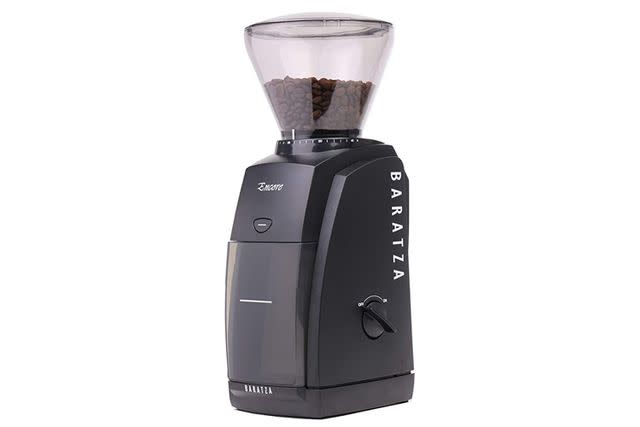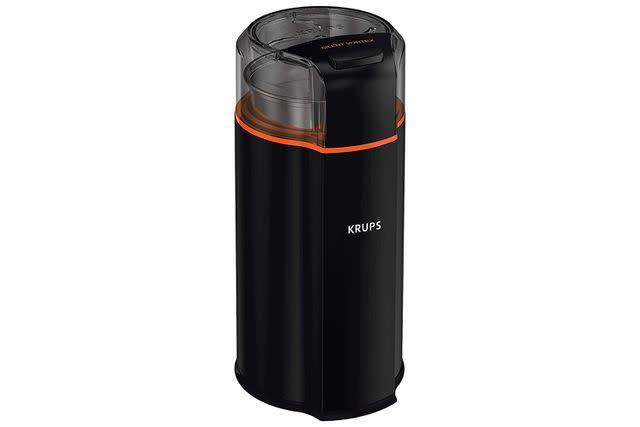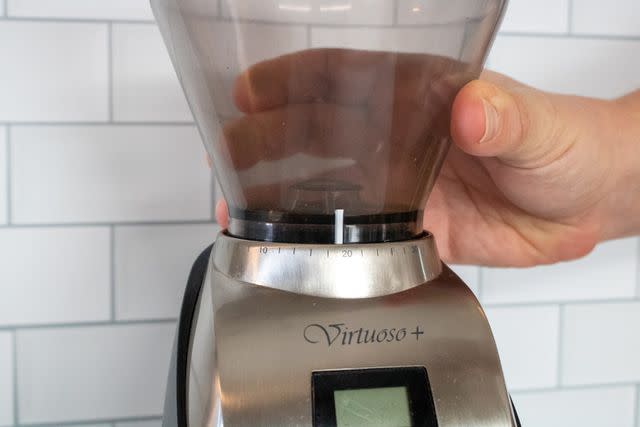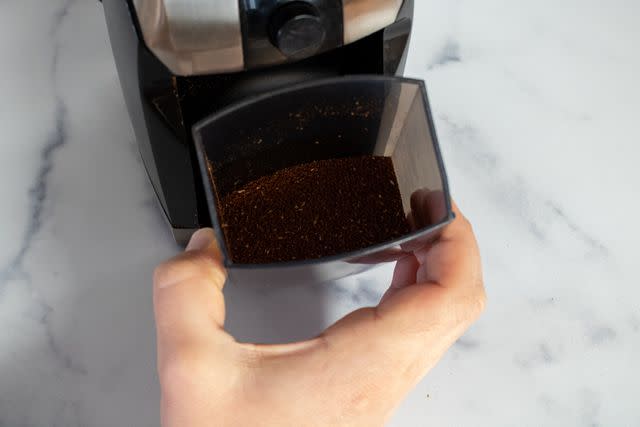How to Grind Coffee At Home, According to Experts
Dotdash Meredith and Yahoo Inc. may earn commission or revenue on some items through the links below.
Grinder or no grinder, baristas share their best tips.

Without even knowing it, you've probably grown up with the sound of coffee grinding. Think about the coffee aisle in the supermarket, where large industrial grinders take whole beans and divvy them into small pieces. The practice of coffee grinding is so ubiquitous that it's even a bonus task on the television show Supermarket Sweep — both the original show and the newly rebooted version. Contestants can patiently grind a bag of coffee for extra cash.
Grinding coffee is an essential step in the brewing process, and with so many affordable options, it's a step you should consider taking out of the supermarket and into your home. Like many things at the supermarket, coffee is a food item that begins to stale faster if you grind your coffee ahead of time. Grinding at home will allow you to enjoy the freshest, tastiest version of your favorite brew: Here's everything you need to know about how to grind for any situation.
Why The Grind Matters
Grinding makes coffee particles small enough so that when you pour water, the water can extract flavor. If you simply threw whole beans into your coffee brewer, you'd end up with slightly coffee-flavored water because the water can't penetrate the beans and find all the good-tasting stuff we're looking for. Grind size "ultimately impacts how water flows through the coffee bed, the corresponding extraction rate, and thus the final taste of the coffee you've brewed," says Sierra Yeo, the 2022 UK Brewers Cup Champion. Simply put, grinding coffee changes the available surface area for water to interact with coffee — the more surface area, the more water can hang out with and pull flavor from beans.
One way to think about grind size is to visualize how water would flow through a bunch of rocks versus sand. Sand particles are much smaller and have more surface area, so water would move through much slower than through rocks. Ground coffee is the same: The finer the grind, the slower water will move, and vice-versa. You might think then that you should grind your coffee as fine as possible, but, like Goldilocks, there's a sweet spot where you want to extract enough — but not too much — from your coffee.
Grinding isn't just about the size of your coffee particles but their shape and consistency. "The geometry of your coffee grounds, the average size of your ground particles, even the composition of differently-sized-and-shaped particles can affect the final flavor," says Yeo. Water will move through your coffee at different rates if you have particles in your brew that are all different shapes. Very finely ground particles might get too much of their flavor pulled out (this is where you'll get more bitter notes, what we call "over-extraction"), while coarser ground particles won't get enough of their flavor pulled out ("under extraction"). If you have both going on in your brew, it won't just even out — the coffee will taste both bitter and sour simultaneously.
Types of Grinders
There are hundreds of grinders on the market, but most fall within two main categories:
Blade grinders: Blade grinders have a propellor-like blade, usually powered by a motor, that chops coffee into smaller pieces. However, blade grinders are notorious for chopping coffee unevenly, creating particles of all sizes. If you grind coffee with a blade grinder, you sort of never know what you're going to get: you might have particles that are dust-like in size and others that look like giant boulders (sometimes a bean or two might even escape the blade, and not be chopped at all).
Burr grinders: Burrs are usually a set of plates that allow coffee beans to pass through, ensuring that they don't get "chopped" up again and making the resulting ground coffee much more even in size. Burrs can be made from stainless steel or porcelain, and you control the grind size by moving the burrs closer or further from one another. Burr grinders can be automatic (you press a button, and it grinds) or manual (usually involving a crank one must turn).
Equipment You'll Need

Amazon
Burr grinder: Although you could use a blade grinder, you'll get much more consistency with a burr grinder. We recommend the Baratza Encore, a straightforward grinder with 40 different grind setting options. The Encore is beloved by baristas and coffee professionals — including me! — because of its intuitive design, accessible price point, and Baratza's impeccable customer service.
To buy: $170 at amazon.com

Amazon
Blade grinder: If you prefer a blade grinder for its more compact sizing and cheaper price tag, we recommend the KRUPS Silent Vortex Electric Grinder. Simple and straightforward, this powerful grinder features durable stainless steel blades that operate on only one setting. Its grinding chamber holds 3 ounces of whole beans, suitable for 12 cups of coffee.
To buy: $44 at amazon.com
:
Coffee: Pick a whole-bean coffee. Many grocery stores sell pre-ground coffee, so it's essential to read the label. We recommend going with a local roaster or any of our other suggestions.

Food & Wine / Ashley Rodriguez
How To Grind Coffee Beans With a Grinder
Before you begin, you should decide what brewer you will use and decide on a grind setting for that machine. You might have read somewhere that for a French press, for example, you're supposed to grind coarsely, and while that might work for you, it's important to know there's no one right way to grind. "There can be recommendations from manufacturers or experts in the field, but ultimately you can experiment to find out what flavor profile you prefer from your coffees and adjust your grind size to achieve that," says Yeo.
The longer a coffee spends in contact with water, the coarser you'll grind. That's why you'll see coarser grind recommendations for French presses, which brew by being in direct contact with water for around four minutes, but for espresso, you might read that you have to grind very finely. But really, it's all about what works for you. "Most brewers are versatile enough to accommodate a few grind size settings, recipe allowing," says Yeo. "It's incredibly subjective."
If you're not sure, use this as a general guide:
Very coarse: Cold brew, since it steeps in water for anywhere between 12-24 hours
Coarse: French press, but feel free to experiment! More and more coffee folks are challenging the way traditional brew methods are often thought about, including experimenting with French press recipes.
Medium: Most automatic coffee brewers
Medium-fine: Pour over methods like a V60 or Kalita Wave
Fine: Espresso, Turkish coffee, Aeropress
Measure out your beans: It's helpful to have a scale for this step so you know exactly how much coffee you're using. Many coffee brewing recipes recommend a 1:16 ratio of coffee to water. For a 12-ounce cup, that's about 25 grams of coffee.
Pour beans into the hopper: The hopper is the chamber on top of your grinder. You might be tempted to fill the hopper with coffee, but it's better to store your coffee in the bag it came in and then measure each dose per brew.
Choose your grind setting: On many models, like the Encore, you switch the grind setting by moving the collar on the hopper. A smaller number corresponds with a finer grind, and a larger number coarser. This will look a little different depending on the model.
Press the button: Many grinders will have a manual button you need to press as you grind (if you take your hand off the button, the grinder will stop). Some grinders have timers you can set, so they grind with one tap (the grinder in the photos below, a slightly more expensive model from Baratza called the Virtuoso, has this function).
Brew and taste: It's hard to know by sight if your grind setting is correct, so try brewing and see what you taste. If you notice your brew is going quickly and the coffee tastes sour, you might need to grind finer. If your brew clogs your machine or the coffee tastes bitter, you might need to go coarser.

Food & Wine / Ashley Rodriguez
How To Grind Coffee Without a Grinder
If you're in a pinch, you can grind coffee with a few household items like a mortar and pestle or smash beans with a rolling pin. Would we recommend this? Not quite — but we've all been there in moments of desperation.
"I've had a go on a mortar and pestle, as well as a salt-and-pepper grinder," says Yeo. "These are not as effective as a burr grinder, which is designed for grinding coffee beans, probably due to the inconsistency and unevenness of the ground particles that result from the process. If your coffee particles are inconsistently ground, it can affect the clarity of the flavors in your coffee."
If you're going to go this route, try using items that you can clean effectively or that you won't use for other purposes. Coffee has oils inside that can be challenging to clean, so while it might be tempting to power up your blender to grind coffee, the blades at the bottom of the blender can make them difficult to clean — and make your next smoothie taste like old coffee.
Coffee Expiration and Storage
Coffee is like any food item you'd buy at the grocery store — it'll go stale over time if you don't store it properly.
Unlike other foods, however, coffee won't spoil or become dangerous to drink. It's more like crackers or chips: they'll lose some of their vibrancy when not stored in an airtight environment free of oxygen. Older coffee tends to taste flat over time, losing aromatic compounds that make coffee delicious. Generally, you want to buy coffee roasted a few days before you buy and enjoy it within 2-4 weeks after opening.
You don't need a fancy storage container to keep coffee fresh, and most bags have one-way valves that keep oxygen and a resealable zipper closure. If your bag of coffee doesn't have that, you can use a mason jar or some other airtight container and keep it in a drawer or cabinet—light also causes coffee to stale faster.
FAQs
Can I grind coffee beans without a grinder?
Yes! But you will lose some of the consistency that's so important in brewing coffee well. Other makeshift brewing methods will "chop" coffee, meaning you'll have uneven particles that might compromise the quality of your cup.
Is it worth grinding your coffee beans?
Do you know that saying "Four out of five dentists agree..."? The same could be applied to coffee — if you asked five baristas what's the most crucial factor in brewing great coffee at home, they'd point to having a burr grinder. You can make up for and adjust for pretty much anything else, but you cannot make up for poorly ground beans.
Can I use a blender to grind coffee beans?
Technically, yes. But we wouldn't recommend it. Like other makeshift methods, a blender will chop coffee inconsistently, and getting all the coffee oils and residue out of your blender might be difficult.
Our Expertise
Ashley Rodriguez has been a barista for almost ten years and has worked as a manager, trainer, and coffee writer. She’s also written product reviews for websites like Serious Eats, The Kitchn, and Forbes, and she currently works as the managing editor for Fresh Cup, a coffee trade publication.

